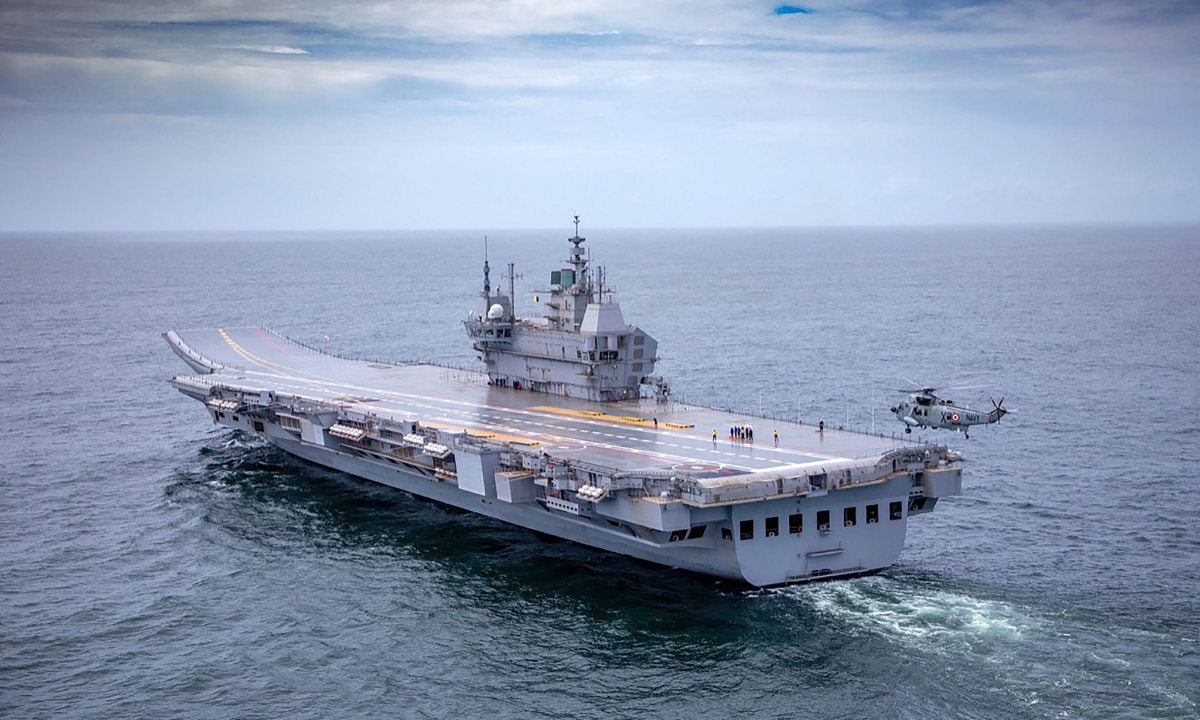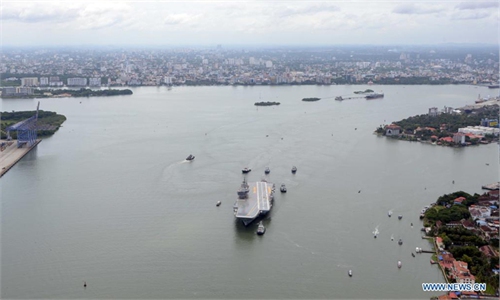
The Vikrant, India's first indigenous aircraft carrier Photo:VCG
Indian navy has recently commissioned one of its biggest ever warships, the INS Vikrant, a 42,800-tons vessel. This is the second aircraft carrier taking the name Vikrant, which means "stepping beyond" or "courageous."
At 262-m long and 62-m wide, the Vikrant can carry nearly 26 fighter jets (MiG-29K), 4 airborne early warning helicopters (Ka-31) or 4 multirole helicopters (MH-60R). There are also reports indicating the Indian navy's interest in fielding Rafael-M and F-18 Hornets, however, this remains to be seen as the carrier has to complete a long cycle of sea trials.
Taking almost 23 years and consuming $2.9 billion, the INS Vikrant showcases India's desire for strategic flexibility. Strategic flexibility, as Iskander Rehman at Institute of Defence Studies and Analysis, New Delhi, argues in 'India's future aircraft carrier force and the need for strategic flexibility' published in 2010, is that India had endeavoured for a 3-carrier fleet, one on each seaboard and the third as reserve.
Dubbed as a path to "atmanirbharta" or self-reliance by Indian prime minister Modi, the INS Vikrant carries roughly 75 percent of indigenous components. Modi claimed that Vikrant represented a sign of India regaining its lost might; and that the new vessel signified India's parting with the "last spots of slavery." Its entry into active service on September 2, 2022, Vikrant has been labelled as a "game changer," enabling India to fulfil its self-assumed role of net-security provider in the region. The carrier is also being boasted as the outcome of a "growing maritime consciousness" in India.
Does India really need an aircraft carrier and if it does, then what kind and for what purpose? These and similar questions have been raised, not just at the commissioning of the new aircraft carrier but long before India's strategic direction began to see such vessels as a premium to securing India's national interests. Stephen P. Cohen and Sunil Dasgupta in their seminal work "Arming without aiming: India's military modernization," published in 2010, explored the reasons of India's military build-up that according to them was going without a clear purpose or direction. Cohen and Dasgupta observe, "India's military modernization suffers from weak planning, individual service-centred doctrines, and disconnect between strategic objectives and the pursuit of new technology." India's acquisition of aircraft carriers, the duo opine, is out of sync with the ground realities and the modernization needed to combat new threats.
Another aspect of the carrier's induction into a navy comes as an outcome of a long strategic debate of the nation's intent or aspirations to be a global player. But such aspirations then need carriers far bigger and far stronger than 42000-ton Vikrant. This would, at least, demand a carrier, as Ashley J. Tellis notes, in excess of 65000-ton with an air combat potential comparable to that of land-based fighters. Though India aims for an aircraft carrier of this tonnage, the IAC-3, but it is not easy saying it would have an operational fate radically different than Vikrant given the fighter selection and long process of carrier construction with sea acceptance vis a vis complex Indian bureaucratic processing.
India's carrier deployment against Pakistan could manifest as a result of strategic coercion or compellence, which given the traditional Indo-Pak rivalry may not bear fruition. With the current capabilities of both Vikramaditya and Vikrant and the peculiar Arabian sea expanse, deploying carriers could be a significant vulnerability, which the Indian naval leadership may not be prepared to bear. Carriers with deficient carrier-borne AEW and land-based limited AWACS means the Pakistani navy and air force would await ceasing such an opportune moment to strike independently or jointly against the Indian carrier battle groups, in any future war at sea.
The Indian navy sees an uncertain operational future for Vikrant, owing greatly to vulnerability on one side and insufficient task effectiveness on the other. Though newer in the service, the Vikrant is nonetheless an embodiment of an outdated design, which may be seen more as a symbol rather than a strength; its warfighting deployment more a conundrum than a capability. This is the dilemma, as the final lines of Crimson Tide underscore, that will occupy Indian navy and the Indian strategic community long after Vikrant takes it formal tour of duty in about 12-18 months from now.
The author is a Pakistani independent researcher. opinion@globaltimes.com.cn

